Final report for ONE15-244
Project Information
The Rich Earth Institute is pioneering the use of sanitized human urine as an innovative and sustainable fertilizer. Wide-scale reuse of urine as fertilizer can provide a stably-priced, locally produced, and sustainable source of fertilizer for farms, while directly alleviating the growing problem of nutrient pollution of surface waters by septic systems and wastewater treatment facilities.
One challenge relating to the storage of urine and its eventual application as a fertilizer is the expense of transporting and storing large volumes of liquid urine until is is needed as a fertilizer. Co-composting urine along with a solid substrate presents the opportunity to incorporate the nutrients from urine into compost while driving off excess moisture as vapor during the composting process. The resulting product, finished compost, can be stored inexpensively and applied using familiar equipment and methods. Our objective for this experiment was to concentrate nutrients from urine by evaporating excess water through composting, and to produce a compost that has a higher nitrogen:phosphorus ratio than typical animal manure compost.
This report covers work done in from the fall of 2016 through the spring of 2017 under a one-year extension of this project. It contains results from four different experiments: 1) a continuation of the hay yield trial begin in 2014, 2) a continuation of a benchtop composting trial, conducted as a follow-up to trials done in 2015 under our SARE project ONE14-218 (Urine as fertilizer: Maximizing hay yield and enriching low-N composts,) 3) a self-heating bin composting trial, 4) and a trickling biological nitrification trial.
The hay trial showed comparable yield between plots amended with sanitized urine and synthetic fertilizer, both of which yielded significantly more than unfertilized plots. The average yields for plots fertilized with urine, synthetic fertilizer, and no fertilizer were 2707, 2969, 1410 kg dry matter/hectare respectively. The difference in yield between plots fertilized with urine vs. synthetic fertilizer was not statistically significant.
The benchtop compost trial produced composts with nitrogen content as high as 3.8% dry weight, with nitrogen retention fractions as high as 75%. Both leaf compost blends (using pure urine or concentrated urine) had nitrogen retention rates of roughly 65%. In contrast, the manure/shavings blends varied greatly, with the recipe using pure urine retaining 75% and the recipe using concentrate retaining only 34%. Seedling germination and growth of Lepidium sativum in both composts using pure urine were similar to that in control media, while growth, and in some cases germination, were reduced in the composts using concentrated urine.
The self-heating compost trial employed two compost recipes: leaves with pure urine, and leaves with urine concentrate. Both piles reached thermophilic core temperatures in excess of 55°C. Total nitrogen content was 2.0 to 2.7% of dry weight, while nitrogen retention within the leaves/urine pile was 65%, versus 48% in the leaves/urine concentrate pile. Leachate from both piles contained markedly less nitrogen per volume than their respective urine sources. Seedling germination and growth of Lepidium sativum in both finished composts were similar to that in control media.
The nitrification trial did not appear to achieve significant nitrification of added urine.
Introduction:
Our project addresses two problems, one affecting farms and the other affecting the natural environment. Each problem, if addressed correctly, provides the solution to the other.
Problem 1 – Unsustainability of synthetic fertilizer – Fertilizer prices have fluctuated sharply in the last ten years and are a major expense to farmers. Nitrogen is tied to the volatile price of fossil fuels. Phosphate is a finite resource and the Global Phosphorous Research Initiative predicts a restriction of the rock phosphate supply within 40 years. Reliance on synthetic fertilizers is an unsustainable option.
Problem 2 – Nutrient pollution – Ponds, lakes, and coastal estuaries throughout the Northeast are heavily impacted by nitrate and phosphate pollution caused by human activity. Agriculture plays a role, but wastewater is often the principal source of nutrient pollution in heavily populated watersheds. 70% of the nitrogen and 50% of the phosphorous in wastewater is from urine, with feces contributing a relatively small share. Many wastewater plants and most septic systems are unable to control nutrient pollution and are poorly suited to nutrient reclamation.
The most common method for reusing nutrients from human waste is land application of sewage biosolids, which can contain heavy metals, chemical wastes, and other persistent pollutants. Biosolids capture only a fraction of the nutrients in sewage, the rest being discharged into rivers. Collecting urine (using specially equipped toilets and urinals) for reuse on farmland could eliminate 70% of the nitrogen from wastewater and carries no risk from heavy metals or industrial chemicals.
Diverting urine from the waste stream protects water quality by recycling N, P, K, and micronutrients back to agriculture. This produces a sustainable, local fertilizer that has the potential to be a dependable and inexpensive resource for many farmers.
Two challenges of using urine as fertilizer are that: 1) it is dilute, containing only 5 grams of nitrogen per liter; and 2) the nitrogen is present as ammonia, which can be lost to volatilization. Our research develops practical tools for handling those two issues.
To incorporate this novel strategy, American farmers need well-documented guidance based on practical experience from successful demonstration projects.
Urine recycling could shift our agricultural practices from a linear, unsustainable use of nutrient resources into a sustainable, closed-loop nutrient cycle. Previous research by the Institute has shown that urine is an effective fertilizer for hay, and field tests in Germany and Sweden have proven that urine-based fertilizer is suitable for growing grains.
Our objective is to test whether composting can transform urine into a fertilizer with better handling, storage, and application characteristics than untransformed urine. We will test three methods: 1) co-composting urine with a high-carbon feedstock in a bench-top incubator, 2) co-composting urine with a high-carbon feedstock in self-heating bins, and 3) using finished compost as a nitrification medium for transforming urine into a stabilized liquid product.
These strategies for converting urine into compost or a stable liquid fertilizer aim to transform the ammonia into non-volatile nitrate or organic nitrogen, while driving off a portion of the water through evaporation. Costly sealed tanks will no longer be needed for storage, and the product will be a stable, more concentrated fertilizer, compatible with manure spreaders. This also helps balance the high phosphorus levels often found in compost, because urine is proportionately high in nitrogen.
An additional objective is to refine our previous research on the direct application of sanitized urine as a liquid fertilizer on hay, by examining if there is a yield difference in hay fertilized with urine or synthetic fertilizer at a given nutrient loading rate.
Cooperators
Research
Hay yield trial
A second season of urine application and hay yield measurements were undertaken at Whetstone Valley Farm, using urine, synthetic fertilizer, and a no-fertilizer control. Methods follow those reported in the previous year study from 2014, with the exception that the 1:1 urine/water dilution treatment was discontinued in order to increase the number of replicate plots treated with either synthetic fertilizer or pure urine. The goal was to better detect any difference in yield between those two treatments.
Incubated compost
Our previous trial was conducted at 30°C, using four feedstock combinations of horse manure, wood shavings, and shredded leaves, each formula then being mixed with pasteurized urine. In that trial, the leaf substrate was the most effective at retaining nitrogen in the finished product (retaining 83% of feedstock N), while horse manure/wood shavings recipes performed poorly (retaining 45% to 53%). Of the manure/wood shavings recipes, respiration rate was highest for the recipe containing the highest manure fraction and lowest for the recipe with the lowest manure fraction. This difference in respiration rate was reflected in the degree of degradation apparent in each end product.
These results informed the choice of compost recipes used to fill the four vessels in the new 50°C trial, which is described in this report. Based on good performance in the 30°C trial, two substrates were chosen for continued study in the 50°C trial: the leaf substrate, and the manure/wood shaving substrate with the highest manure fraction (85% manure/15% shavings [wet weight]).
Along with the two substrates under investigation, we also tested two urine products: pasteurized urine (containing 5.64 g N/L), as was used previously, and a new urine concentrate (containing 21.4 g N/L) made using reverse osmosis. This addition represented another strategy: partial dewatering of urine through reverse osmosis before addition to the compost, which would allow more nutrients to be added to the compost without adding excessive moisture.
For the 50°C trial, two replicate vessels were filled with 85%/15% manure/shavings mix, and the other two vessels were filled with leaves, resulting in four vessels total. One of the two manure/shavings replicates and one of the two leaf replicates were wetted with pasteurized urine, while the other replicate of each substrate type was wetted with a pasteurized urine concentrate, produced using a reverse osmosis process that concentrated the urine by a factor of roughly 4. The four combinations are shown in Table 1.

Table 1: Compost recipes for the 50°C composting trial
Each substrate mixture was placed in a 20 liter aeration vessel, wetted to capacity with treated urine, and incubated it at 50°C. Bedded horse manure and dry hardwood leaves were chosen because of their high C:N ratios, which would be improved with urine. An adjustable air supply ensured adequate aeration. Automated monitoring of the oxygen levels in exhaust air provided feedback to the aeration system, which was programmed to adjust the aeration rate of each vessel individually to maintain at least 10% oxygen in the exhaust. The trial was initiated on 11/15/16 and concluded on 01/13/17.
Compost was removed from the incubator on 1/13/17, and set aside to cure at ambient temperature with passive aeration. Samples were reserved for laboratory analysis and Lepidium sativum germination testing. Compost analysis was performed by the analytical lab at the University of Maine, and is reported below in Table 2. Germination testing was performed on both aged material (cured for six months) and on refrigerated samples taken at the time the compost was removed from the incubator, with results reported in Table 2 below.
Self-heating bins
The self-heating bins were intended to more closely approximate larger-scale composting, where temperature varies naturally over the life of the compost process and the surface-area-to-volume ratio of the pile is closer to that of a large-scale pile or windrow. To further approach conditions in a large pile, the walls of the bins were insulated with 2” of XPS insulating board (R-10). Compost was supported on a perforated platform above the bin floor to allow for free drainage and aeration was provided by blowing air into the space below the platform.
The entire compost mass was contained within a closed polyethylene membrane with a single exit port, and oxygen levels within the containment membrane were measured with a Vernier O2 Gas Sensor (model O2-BTA) and electronically logged every minute using an Arduino microcontroller. As in the incubator test, an adjustable air supply coupled to the oxygen analyzer ensured an adequate aeration rate to maintain at least 10% oxygen in the exhaust.
Recipes for the self-heating bin trial used lightly shredded leaves as the solid feedstock in both Bin A and Bin B, while Bin A received pasteurized urine (containing 5.95 g N/L) and Bin B received a pasteurized urine concentrate (containing 21.8 g N/L). This is the same feedstock combination as was used in Bin 3 and Bin 4 of the incubator trial. The main difference in the feedstocks between the incubator trial and the self-heating bins was that the leaves available for the self-heating bin trial were noticeably damp, and were only coarsely shredded.
Ammonia volatilization was quantified by bubbling exhaust air from each vessel through trap containing 1 L of 0.45 N sulfuric acid. In the benchtop trial, all exhaust passed through the trap, while in the larger bin trial only a controlled fraction of the exhaust air was directed into the trap. A 40 mL sample of acid solution was removed from each trap periodically and frozen for later analysis. At the end of the experiment, all samples were thawed, mixed, and titrated to pH 7.0 with NaOH to determine how much acid had been consumed, and by extension how much ammonia had been trapped.
Urine and urine concentrate were added in phases as the bins were filled with leaves on 2/17/17. Excess liquid that accumulated in bottom of the bins was pumped out on 2/26/17, weighed, and reapplied to both piles. Liquid that collected at the bottom of the bin after this reapplication was pumped out again and samples frozen for later analysis. Additional leachate was pumped out on 3/22/17 and 4/14/17, weighed, sampled, and frozen.
Leachate was recycled as the absorptivity of the compost allowed, and excess leachate was removed and stored for analysis. Self-heating bin composting was begun on 2/17/17 and samples were removed for analysis on 05/03/17 (see Table 3). Compost samples were refrigerated, and the remaining compost was allowed to age with passive aeration at ambient temperature. Germination trials were then performed on both aged and refrigerated samples using Lepedium sativum (Garden cress).
Nitrification
Biological nitrification is capable of transforming a significant fraction of the nitrogen present in human urine from ammonia to nitrate, as pioneered by the Swiss Federal Institute of Aquatic Science and Technology (EAWAG). A nitrification experiment was included in this SARE project to test the ability of compost to serve as a biologically active matrix for nitrification of the ammonia in urine. After the experimental method for this project was submitted, we performed an informal and uncontrolled test where additional urine was added to urine-derived compost samples, in excess of the liquid holding capacity, to inform the execution of this experiment. Wide variation and rapid fluctuations in the pH of the resulting leachate suggested that the process might not be stable, and the experimental design was therefore altered from the original plan.
Our proposal called for testing the ability of a single compost type to nitrify the ammonia in a single urine product. In order to test more combinations of compost and urine product, we increased the number of compost types tested to three, and the number of urine products to three, for a total of nine urine/compost combinations. Compost type included cured urine/leaf compost from the 50°C trial, cured urine/manure/shavings compost from the 50°C trial, and a cured urine/leaf compost from an uncontrolled compost batch with high nitrate levels (6022mg NO3-N/kg) and a low pH. Nine PVC columns measuring approximately 1” diameter x 10” long were packed with a 50:50 mix by volume of the various compost substrates and dry wood shavings. In addition, a portion of each compost substrate was baked at 100°C for 12 hours to deactivate any nitrifying bacteria and used create an essentially nitrifier-free substrate, resulting in three more columns for a total of 12. Each column was dosed twice daily for 12 days with with 10 mL of either urine, urine diluted 3:1 with water:urine, urine concentrate. Urine and urine concentrates were the same as were used in the incubator compost trials. The baked substrate columns (1, 5, and 9) were dosed with urine.
Hay yield
Results are reported in the attached statistical analysis document. As before, no significant difference in yield was detected between hay fertilized with synthetic fertilizer or urine when applied at the same nutrient loading rates.
Incubated compost
Due largely to the relatively lower moisture content of the leaf substrate compared with the manure/shavings substrate, the leaves were able to absorb and retain roughly 2.4 the volume of liquid per volume of substrate as the manure/shavings mixture. Viewed on a mass basis, the difference is even greater: over the first 45 days of composting, net liquid absorption of the manure/shavings mixture averaged 0.33 L urine/kg of matrix material (wet weight), compared to 1.4 L/kg for leaves.
Because of the high performance of the leaf substrate, it was chosen to be used exclusively in the final composting trial using larger compost volumes, also reported in this document.
There were major differences between the manure/shavings compost and the leaf compost in terms of the source and fate of moisture. Because of the high moisture content of the manure (79%), the manure/shavings substrate contained more moisture (69%) than the leaf substrate (12%) before the addition of urine. After urine addition, the manure recipes contained about 80% moisture, while the leaf recipes contained only about 60% moisture. Despite its lower total moisture level, the leaf recipe contained about 20% more urine by volume than the manure/shavings recipe. As a result of the high moisture content of the manure, only approximately 45% of the total moisture in the manure/shavings recipes came from urine, while urine was the source of about 90% of the moisture in the leaf recipe.
Over the first 45 days of the trial, all leachate was collected from the four vessels, and recycled back into the compost as needed to maintain adequate composting moisture. Vessels 1 and 2 (containing the manure/shavings substrate) produced significant leachate, (1.2 and 0.9 L, respectively,) and remained wet to the touch. Vessels 3 and 4 (containing the leaf substrate) dried considerably during that period, allowing all leachate to be recycled back into the compost, and an additional 300 and 500 mL of water to be added to vessels 3 and 4 respectively.
Table 2 shows the starting mass and moisture content of each recipe, as well as figures relating to net urine absorption. Negative leachate production masses reflect the addition of water to maintain adequate moisture for composting.

Table 2: Moisture properties of the four composts
Nitrogen content and retention rate within the four compost recipes varied greatly (Table 3), which is not surprising, given the great disparity in C:N ratios in the starting recipes shown in Table 6. As shown in Table 3, the leaf compost with urine concentrate (Bin 4), had the most total nitrogen as a percentage of dry weight (3.80% N), while the manure/shavings blend with urine (Bin 1) had the highest nitrogen retention rate (75% of initial N). The manure/shavings mix with urine concentrate retained only 34.2% of its starting nitrogen, which might be expected based on its starting C:N ratio of 9.5. In contrast, the leaf and urine concentrate had a similar C:N ratio of 11.3, but retained 66.8% of its starting nitrogen, on par with the leaf and urine mixture. The ability of the leaves to retain nitrogen at such a low starting C:N ratio stood out strongly against the manure/shavings mixture. Results from the acid traps confirmed that ammonia was being lost at a much greater rate from Bin 2 than from the others (see Table 4). The complete compost and feedstock analysis for the incubated compost trial is given in Table 5.

Table 3. Nitrogen content of feedstocks and final compost in incubator trial, nitrogen retention rates
| Bin # |
NH4-N captured |
| 1 | 4.2 g |
| 2 | 22.2 g |
| 3 | 1.7 g |
| 4 | 12.0 g |
Table 4. Ammonia captured in acid trap from incubated bins. May not represent all ammonia lost.

Table 5. Compost and feedstock analysis for the incubated trial
Self-heating bins
The self-heating bins performed generally as expected regarding heat development, despite being located in a unheated winter greenhouse (Figures 1 and 2), missing data from Bin B due to failure of datalogger), with core temperatures rising quickly into the thermophilic range and then tapering off over time. Nitrogen retention (Figures 1 and 2) varied more between the two bins (A: leaf with urine, and B: leaf with urine concentrate), than when the same recipes were tested in the 50°C incubator trial (Bins 3 and 4). Bin A retained roughly 2/3 of initial N and Bin B retained only 1/2. This may have been due at least in part to uneven moisture distribution throughout the bins. Although the finished compost from both bins contained roughly 70% moisture, most of the moisture had migrated to the edges of the pile and the center was relatively dry. Coupled with the high pH of 8.7 and high free ammonia levels in Bin B, ammonia loss would be accelerated. Mechanical mixing to evenly distribute the moisture within the compost mass might increase the nitrogen retention. The complete compost and feedstock analysis is given in Table 9.
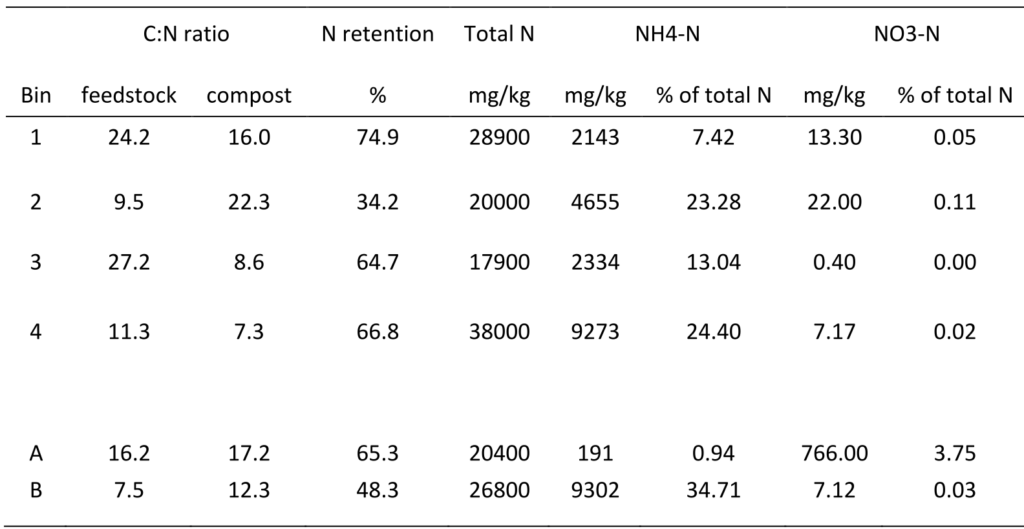
Table 6. C:N ratio of feedstock blend and compost; N retention fraction, total N, and N species in composts removed from incubated and self-heating bins
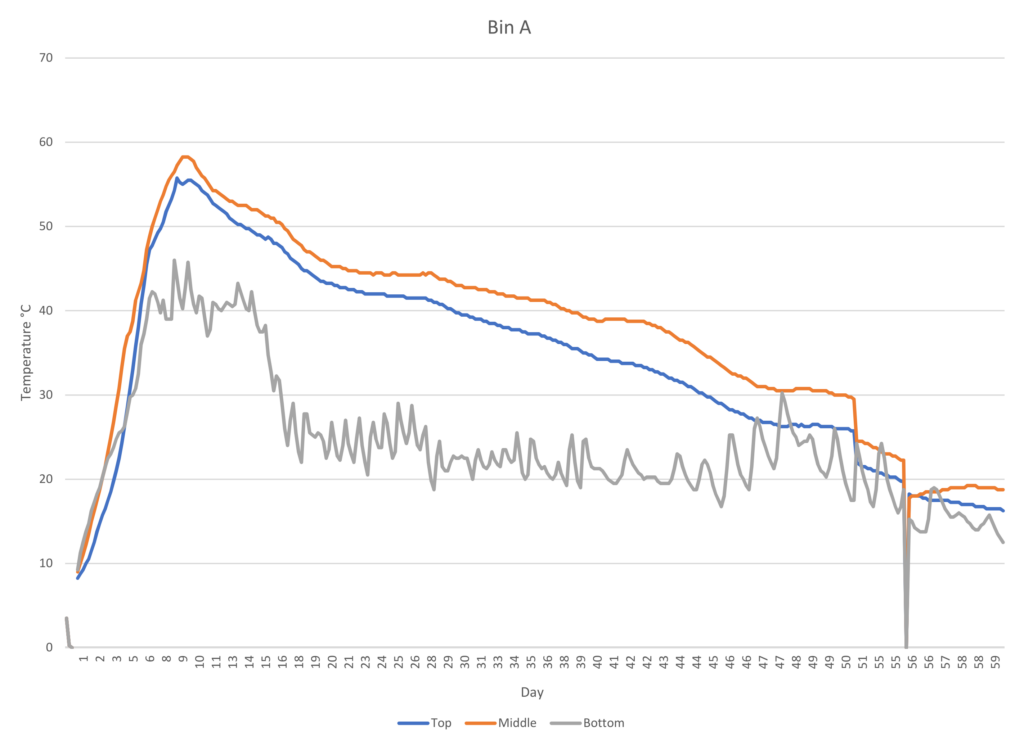
Figure 1. Temperature in center of Bin A
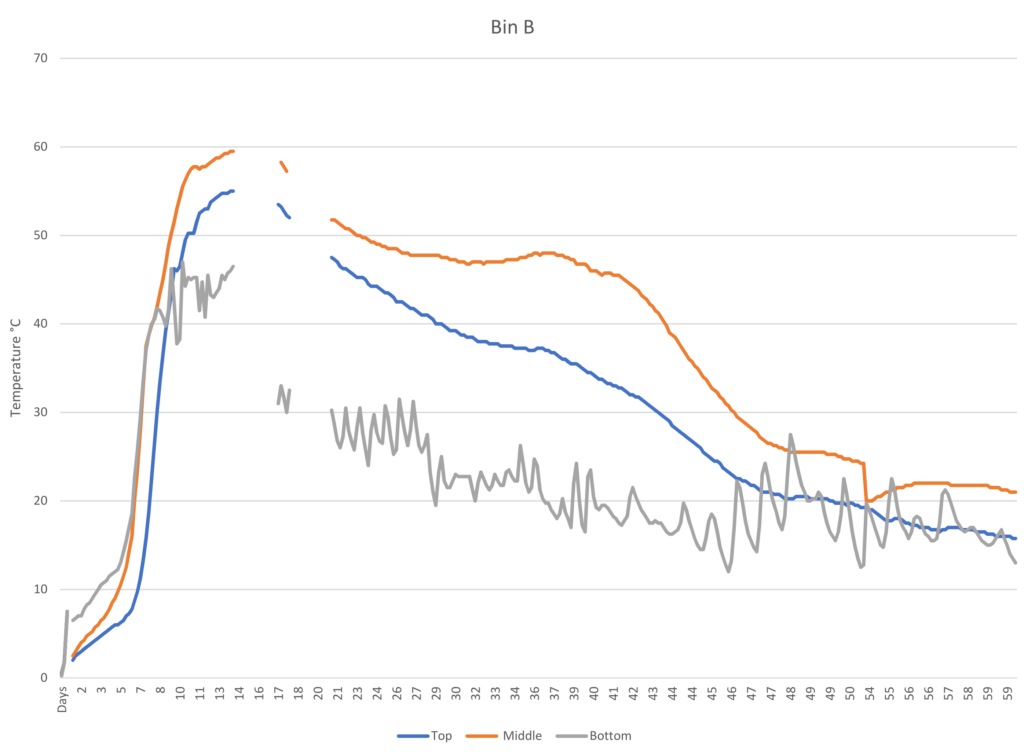
Figure 2. Temperature in center of Bin B
One surprise from the self-heating bin trial relates to the leachate produced when urine was applied in excess of the liquid holding capacity of the leaves. Urine and urine concentrate were applied to the leaves in the two bins and the leachate was collected. It was then reapplied, and the resulting leachate was collected again. Analysis of that second-pass leachate showed that the nitrogen content was greatly reduced, suggesting that a large fraction of the nitrogen had been retained by the leaf matrix. Additionally, the odor of the leachate was very mild and inoffensive, in contrast to the strong-smelling urine and urine concentrate. Additional leachate accumulated at a low rate throughout the trial, and the nitrogen content continued to drop, as shown in Table 7.
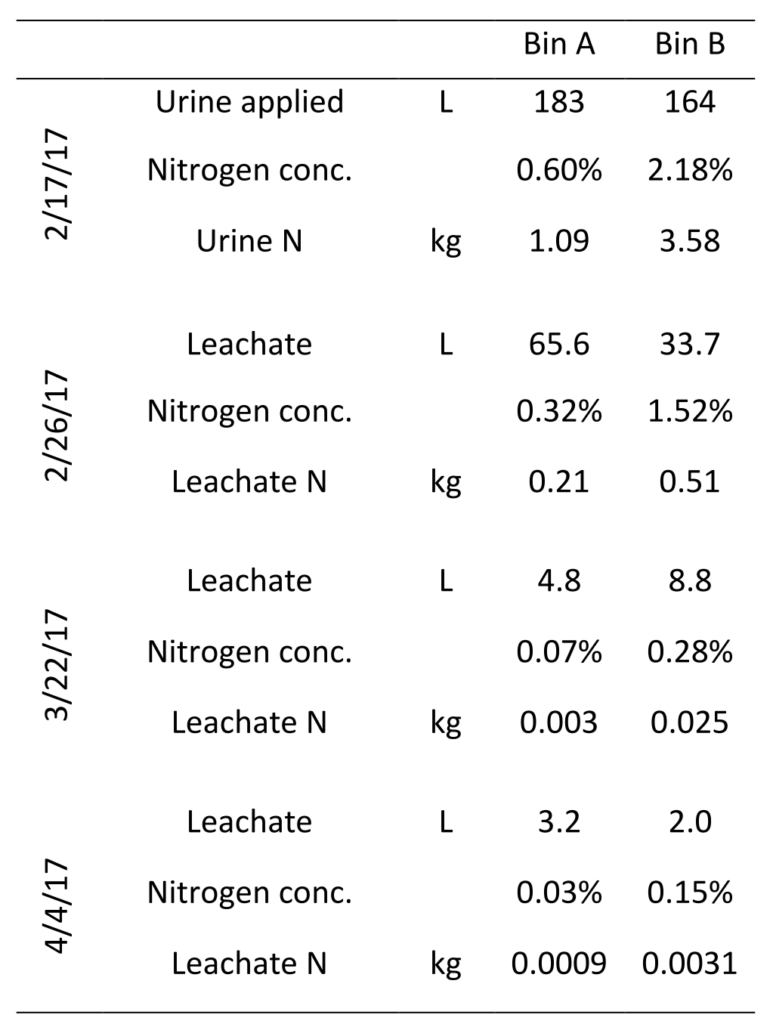
Table 7. Leachate production and nitrogen content--self-heating bins
A germination and seedling growth test using Lepidium sativum (garden cress) showed some differences between composts (Table 8). All composts had germination rates on par with the control, except for the fresh and cured compost from Bin 4, which both exhibited only 80% germination. Growth was much more varied among composts. The incubated composts which received urine concentrate (Bin 2, and more notably Bin 4) had the effect of markedly reducing seedling growth rates, possibly having to do with salinity levels or free ammonia. These composts would not be well suited for potting soil, but would likely still be a good source of nitrogen and organic matter in a row cropping setting where they would be diluted by mixing with soil.

Table 8. Germination and seedling growth of incubated and self-heating composts

Table 9. Compost and feedstock analysis for the self-heating trial
Nitrification
Leachate from the columns was analyzed at the Agricultural and Environmental Testing Laboratory at UVM for nitrate, nitrite, and ammonia, with results reported in Table 8. No nitrate was detected in the leachate from the first two composts from the 50°C trial (columns 1 through 8), but substantial levels of nitrate (from 1394 to 1944 mg NO3-N/L) were detected in the leachate from the third compost (columns 9 through 12). Because the compost itself had 6022mg NO3-N/kg and 3723 mg NH3-N/kg (dry weight), it was unclear if the nitrate in the leachate was from the substrate or the added urine. But judging by the change in pH of the leachates from this substrate over the length of the trial (from under pH 5 to over 8) it appeared that any nitrification that may have been occurring at the beginning was likely overwhelmed by the addition of ammonia in the added urine. Future trials could use a compost substrate from a younger compost to possibly start with more nitrifying bacteria and also follow a slower application rate to avoid raising the pH though excessive ammonia addition.
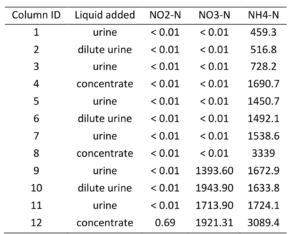
Table 8. Nitrite, nitrate, and ammonia levels in leachate from nitrification columns
Co-composting urine with high-carbon feedstocks appears to be an effective way to bind the nitrogen in urine into a solid form that can readily be stored and applied using conventional machinery. The product can have up to 10 times more total elemental nitrogen than phosphorus, achieving the goal of producing a compost with a high N:P ratio.
Hardwood leaves appear to perform better than a manure/shavings mixture for co-composting urine as measured by two metrics: absorption and incorporation of the largest volume of urine with the smallest volume of solid substrate (as established in this trial) and reasonable retention in the finished compost of nitrogen originating in the urine (as established in the previous 30°C trial discussed in our final report for ONE14-218, and confirmed by the 50°C trial reported here).
The odor characteristics of leaf/urine co-composting are very favorable, and make composting urine more aesthetically acceptable than might be imagined.
When used in composting, urine concentrate is more prone to nitrogen loss than is pure urine--but since a small volume of concentrate can supply a large amount of nitrogen, urine concentrate could be an effective way to add nitrogen to wet, high-carbon feedstocks that cannot accept much additional moisture. When adequate moisture levels are maintained, a leaf/urine concentrate recipe is capable of retaining most of the starting nitrogen present in the mix.
Not all urine/leaf composts are suitable for use with seedlings or tender plants, possibly due to high ammonia content. This same ammonia content, however, would make such compost an effective fertilizer if it were incorporated into soil for row cropping.
Based on test results of the composts produced in these multiple trials, it is possible to use urine to create high-nitrogen compost with safe ammonia and salinity levels, and further research is needed to establish best practices.
Education & Outreach Activities and Participation Summary
Participation Summary:
Learning Outcomes
Participating farmers learned about the fertilizing potential of human urine and derivatives, and learned how to store, sanitize, and apply it ways that protect human and environmental health while effectively adding nutrients to their fields.
Project Outcomes
Jesse Kayan, owner of Wild Carrot Farm in Brattleboro, says, “Our farm uses land that has been the recipient of Rich Earth’s urine applications for many years now. Having used their product as fertilizer on our small, diversified farm we have had the opportunity to experience the benefits of this system directly. As a result of past destructive practices, our hay land is fragile and low-yielding. Over the several years the Rich Earth Institute has applied urine, we have watched our yields increase dramatically. As a result, we can now make a whole additional cutting of hay each season, increasing our productivity and profits. The urine has not only increased our land’s value, it has helped make significant improvements to the soil’s fertility and resilience. We feel extremely good to be building our soil while removing a pollutant from the waste stream.”
A key to this project's success was that it consisted of a collaboration between dedicated researchers and motivated farmers, all of whom were excited at the prospect of closing the nutrient cycle and bringing nutrients from human urine back to the farm. This motivation helped all parties to persevere through the many challenges posed by using a novel and unfamiliar farming input, and to have patience for the extra steps required in conducting field research.
This partnership will continue because a) the two participating farms have adopted the practice of fertilization with sanitized human urine and have integrated it into their on-farm nutrient management activities, and b) the research partner (Rich Earth Institute) has developed academic collaborations with university partners at multiple institutions, and has secured additional funding to develop value-added fertilizer products from urine that will increase their usability and practicality as agricultural inputs.
Additional study is needed to optimize composting methods involving urine and bring them to scale, including assessing the suitability of other high-carbon feedstocks currently available in the Northeast, and conducting mechanically turned windrow trials. Further study is also needed to improve methods such as nitrification, reverse osmosis, evaporation, and other methods for reducing the volume and stabilizing the nutrients in urine for more efficient storage and crop uptake. Finally, a comparative study of a range quantifying crop uptake efficiency vs. nutrient loss to the environment from urine-derived fertilizers, (including compost and urine concentrate,) would shed light on what urine-derived products and application methods best support agricultural production while protecting environmental health and water quality.